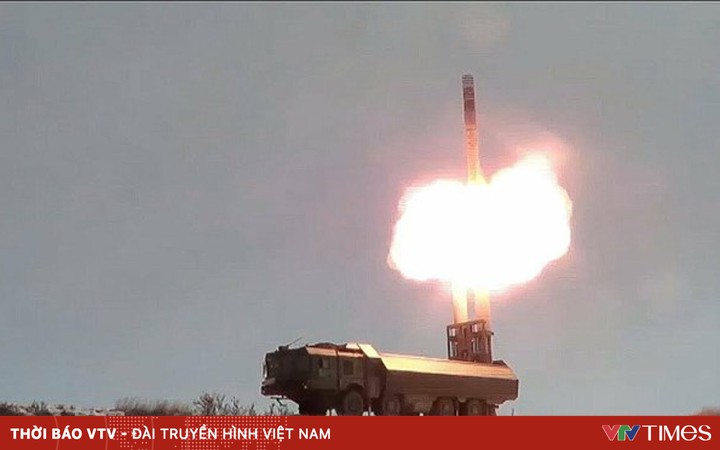Many of Russia’s advanced weapons use American components, putting the country’s military at risk when Washington and its allies tighten sanctions.
With a magnifying glass, screwdriver, and a torch, two researchers from a special investigation team pry open Russian weapons and equipment that have been seized on battlefields in Vietnam. Ukraine.
During a business trip to Ukraine last month, these specialists studied all the advanced equipment of the army Russia that they can reach, from laser binoculars or cruise missile guidance.
Researchers, invited by Ukraine’s security service to analyze Russian assets, found that most of them contained parts from companies based in the United States, as well as allies in the European Union. Europe (EU), such as chips, circuit boards, motors, antennas…

Locals climb aboard a destroyed Russian tank near the city of Irpin, northern Ukraine, on May 6. Image: Reuters.
“Russian advanced weapons and communications systems are mainly built on Western chips,” said Damien Spleeters, one of the investigators from the UK-based Conflict Arms Research Company. Russian companies have been receiving a “stable supply” of American and Western technology and components for decades, the company added.
America has long prided itself on providing technology and weapons to the rest of the world. But since Russia launched its military campaign in Ukraine in February, Washington has been faced with a harsh reality: The weapons Russian forces use in Ukraine are being greatly aided by advanced technology. of America.
But this is also Russia’s technological weakness that the US and its allies can deepen to increase pressure on Moscow. The United States and dozens of allies have imposed a ban on the export of advanced technology to Russia, hampering Moscow’s ability to produce weapons to replace equipment damaged by the conflict in Ukraine.
President Joe Biden’s administration on June 2 announced increased sanctions against Russia and Belarus, adding 71 organizations to a list of banned government purchases of advanced technology.
While some analysts say these sanctions take considerable time to be fully effective, the Biden administration has called it a success.
Since the Western allies announced widespread export restrictions on semiconductors, computers, laser equipment, telecommunications equipment and other goods to Russia in February, Moscow has been is having trouble finding chips for its precision-guided weapons, according to a senior US official who asked not to be named.
Asked on May 31 if the Russian military was struggling with chip shortages, US Commerce Secretary Gina Raimondo, who oversees export control operations, said the answer was ” yes”.
“Exports of US controlled items to Russia, including semiconductors, have fallen by more than 90% since February 24,” she said.
Sanctions prevent advanced technology from the US and dozens of allies and partners from being exported to Russia. They also apply to high-tech goods manufactured anywhere in the world based on American machinery, software or blueprints.
This means that countries not in the sanctions alliance with the US and Europe must also follow the rule, or face retaliatory measures from the West.
Russia has stopped publishing monthly trade data since launching its military campaign in Ukraine, but customs data from the country’s major trading partners show imports of machinery parts, equipment components, and equipment. weakness has decreased sharply.
According to Matthew C. Klein, an economic researcher who specializes in tracking the impact of global import and export control measures, manufactured goods imported by Russia from nine major economies in April fell by 51%. compared to the average from September 2021 to February this year.
Such sanctions are as effective as air strikes on tank factories or shipyards in previous wars, Klein stressed. “Sanctions have an impact not less than bombs, because the Russian military is dependent on imported equipment,” he said.
Russia is one of the world’s largest arms exporters, especially to India, but its defense industry relies heavily on imported components. In 2018, Russia’s domestic supply met only about half of the military-related equipment and services it needed, such as vehicles, computers, optical equipment, machinery and metals. manufacturing, according to data from the Organization for Economic Cooperation and Development.
The rest is imported, with about a third coming from the US, Europe, Japan, the island of Taiwan, Australia and other US partners. Many of them are now jointly imposing sanctions on Russia.
Combined with other sanctions targeting Russian trade, US officials say, export controls have worked. According to them, Russian tank factories have had to reduce worker hours and grapple with shortages of spare parts. The US government has also received information that the Russian military is struggling to find components for satellites, avionics or night vision goggles.
However, some experts remain cautious in their assessment of the effectiveness of technology sanctions.
Michael Kofman, director of Russia studies at CNA, an Arlington-based think tank, thinks the sanctions need more time to have a significant impact on the Russian defense industry.
Maria Snegovaya, a visiting scholar at George Washington University, also said that it was not until the fall that shortages of critical technology and maintenance services began to become widespread in Russian industry, as companies running out of spare parts and supplies, while the need for equipment repair increases.
“The question is, can Russian companies find alternative sources of supply?” she said.

Investigators dismantle parts of a Russian drone captured by Ukraine last month. Image: NY Times.
US officials say Russia has tried many ways to deal with sanctions, but most have so far been unsuccessful. The Biden administration has threatened to block access to American technology for any company that intends to help Russia evade sanctions.
In an interview last month, Minister Raimondo said the United States was not aware of any systematic violations of export control measures imposed on Russia from any country, including China.
“The world knows how serious we and our allies are,” she said. “Companies or countries that try to bypass export controls will have to suffer the consequences.”
However, according to Spleeters expert from the UK, the Russian military used to have very creative methods to overcome barriers to technology import, such as buying foreign products through front companies, third countries. three or more civilian distributors. They could completely use the same method to avoid current sanctions.
Spleeters’ research uncovered attempts to hide Western technology in some Russian devices. During a trip to Kiev, the Ukrainian capital, last month, he and his colleagues disassembled three advanced Azart encrypted radios, equipment that helps Russian forces establish a secure communication channel on the battlefield.
They found that the first two contained microchips with carefully de-branded parts, apparently to conceal their origin. But inside the third radio is an identical chip that the Russian manufacturers apparently missed when removing the branding, suggesting it was made by a US-based company.
Spleeters said it’s not clear who removed the labels of the chips, but the concealment of their origins was clearly intentional. “They’re neatly deleted. Someone knows exactly what they’re doing,” he said.
But according to Spleeters, whether recent sanctions will systematically reduce the supply of chips to Russia remains unclear, given that Moscow has a huge stockpile of Western technology.
The Spleeters team also analyzed three different models of Russian reconnaissance unmanned aerial vehicles (UAVs), two of which are named Orlan and Tachyon and a previously unknown model that Ukrainian officials refer to as the Kartograf.

The circuit board inside a Russian cruise missile obtained by the Conflict Arms Research team during the investigation. Image: NY Times.
Inside the Orlan UAV, they found many parts sourced from companies with headquarters in the US, Switzerland and Japan. In the remaining two UAVs, they found components from corporations in the US, China, Germany, the Netherlands, Korea, Sweden and even Taiwan.
While working, Spleeters asked a member of the Ukrainian security service what he thought when he saw Western parts in Russian weapons.
“It’s just a business,” the man replied.
“Yes, but it’s big business and they just sell chips without caring or knowing how they’re ultimately used,” Spleeters said, referring to Western electronics companies. “I don’t think they have the ability to know who is going to use them and for what purpose.”
Vu Hoang (Follow NY Times)
at Blogtuan.info – Source: vnexpress.net – Read the original article here



